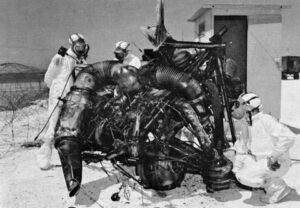25 July 1962 – The Operation Fishbowl nuclear tests were originally planned to be completed during the first half of 1962 with three tests named Bluegill, Starfish and Urraca from Johnson Island. “If a test were to fail, the next attempt of the same test would be of the same name plus the word “prime.”(1)
The first attempt “Bluegill” was successfully launched the Thor missile but radar tracking lost it. Since there were a number of ships in the area, and the trajectory could not be guaranteed as ‘safe’, the missile was destroyed. No nuclear detonation occurred.
The next launch “Starfish” was on June 19, 1962 just before midnight. “The Thor missile carrying the Starfish Prime warhead actually reached an apogee (maximum height) of about 1100 km (just over 680 miles), and the warhead was detonated on its downward trajectory when it had fallen to the programmed altitude of 400 kilometres (250 mi). The nuclear warhead detonated at 13 minutes and 41 seconds after liftoff of the Thor missile.
Starfish Prime caused an electromagnetic pulse (EMP) which was far larger than expected, so much larger that it drove much of the instrumentation off scale, causing great difficulty in getting accurate measurements. The Starfish Prime electromagnetic pulse also made those effects known to the public by causing electrical damage in Hawaii, about 1,445 kilometres (900 mi) away from the detonation point, knocking out about 300 streetlights, setting off numerous burglar alarms and damaging a telephone company microwave link[11] (the detonation time was nine seconds after 11 p.m. in Hawaii).”(1)

“On July 25, 1962, a second attempt was made to launch the Bluegill (Bluegill Prime) device, but ended in disaster when the Thor suffered a stuck valve preventing the flow of LOX to the combustion chamber. The engine lost thrust and unburned RP-1 spilled down into the hot thrust chamber, igniting and starting a fire around the base of the missile. With the Thor engulfed in flames, the Range Safety Officer sent the destruct command, which split the rocket and ruptured both fuel tanks, completely destroying the missile and badly damaging the launch pad. The warhead charges also exploded asymmetrically and sprayed the area with the moderately radioactive core materials.
Although there was little danger of an accidental nuclear explosion, the destruction of the nuclear warhead on the launch pad caused contamination of the area by alpha-emitting core materials. Burning rocket fuel, flowing through the cable trenches, caused extensive chemical contamination of the trenches and the equipment associated with the cabling in the trenches.
The radioactive contamination on Johnston Island was determined to be a major problem, and it was necessary to decontaminate the entire area before the badly damaged launch pad could be rebuilt.”
Source: (1) Wikipedia: Operation Fishbowl
